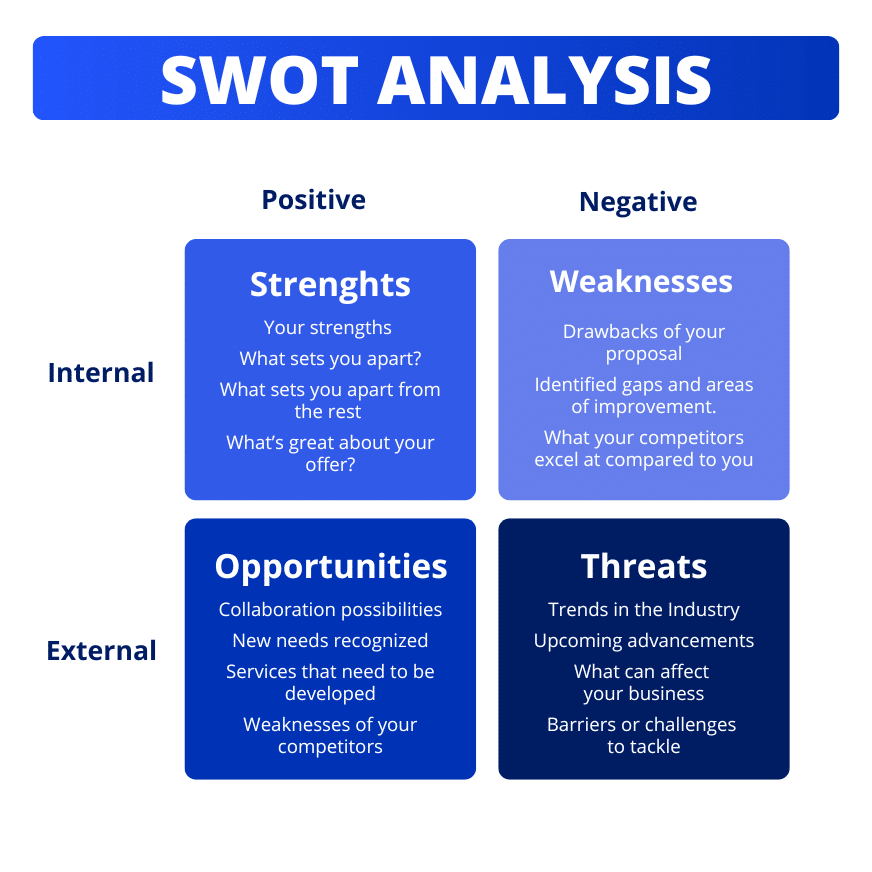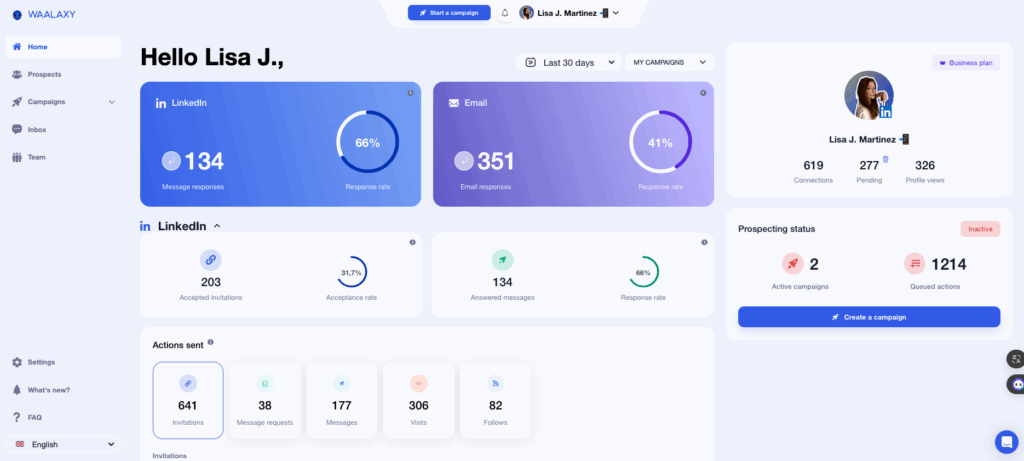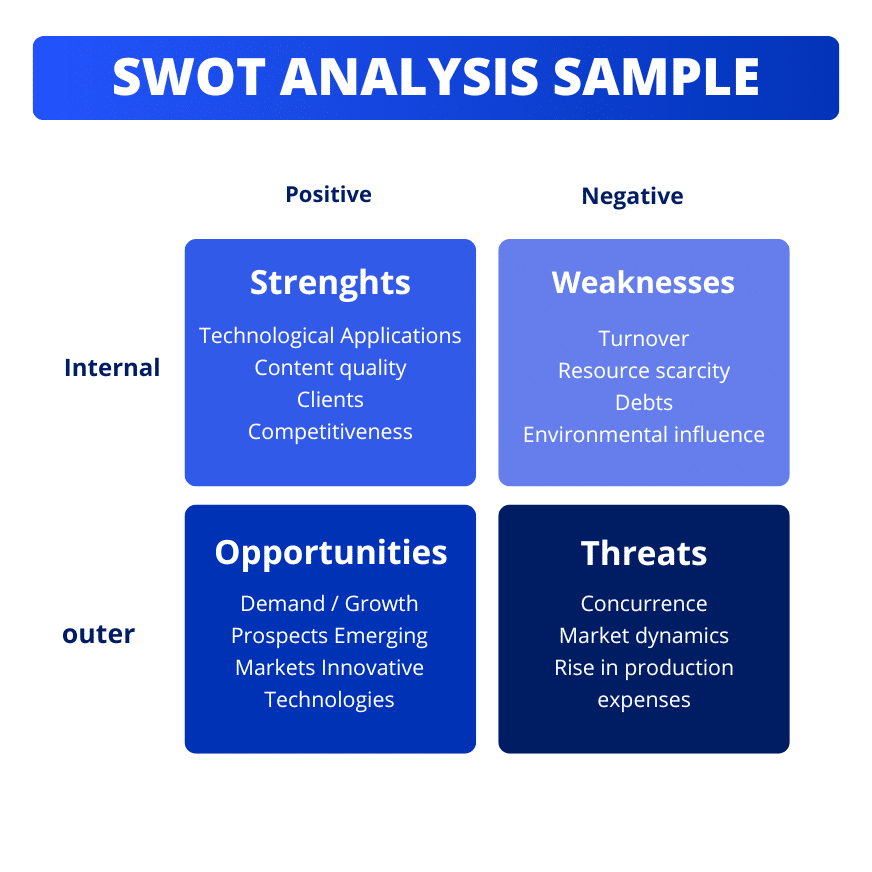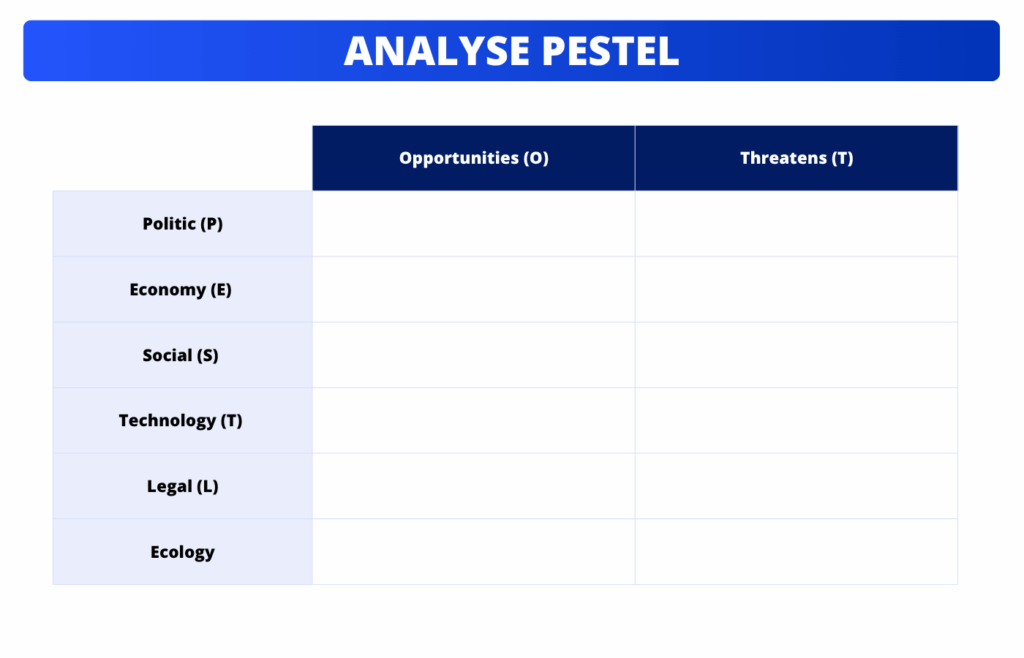SWOT analysis is one of the most powerful—yet often underestimated—tools in a company’s strategic plan. 🤔
In just a few boxes, it allows you to take a step back, align your teams, and transform a mountain of information into SMART actions to achieve your objectives…
Simple in appearance but formidable when used properly, SWOT-TOWS analysis sheds light on key decisions (product launch, pivot, expansion, repositioning…). 👀
We provide a complete overview of the method, with concrete examples, ready-to-use templates, and, above all, advice on how to move from analysis… to strategy. ➡️ On the program:
- What is SWOT analysis? Definition, objectives, template, advantages/disadvantages…
- SWOT method: How to do it? Examination of each element in detail.
- SWOT-TOWS analysis to establish a strategy and subsequent actions.
- 4 SWOT analysis examples: Apple, Amazon, Starbucks, and us (Waalaxy).
We’re off! 🚀
What is SWOT analysis? Template
⚙️ What is SWOT? A strategic management and analysis tool whose name is an acronym for the elements (internal and external to a brand or project) that it will identify:
- Strenghts: competitive advantage and strengths.
- Weaknesses of the company.
- Strategic opportunities available to you.
- Threats or dangers that could affect your business.
The SWOT enables you to assess your company’s current position, define objectives, and then implement a strategy to achieve them.
The SWOT chart was created in the 1960s by Albert Humphrey, a management consultant at Stanford Research Institute, during a study of the performance of various companies.
It is still used today, 60 years after its initial creation. This analysis tool is considered one of the most popular in the business world. 🤯
To help you give visibility to these different elements in your analysis, there is a SWOT matrix that allows you to resemble and visualize them in order to draw conclusions later. 👇🏼

You can reuse this matrix to directly record and classify all your SWOT elements to establish your strategic diagnosis. 🧮
The benefits of SWOT
✅ SWOT analysis has three major advantages that explain its success:
- Simplify complex situations into a single table to make strategic issues comprehensible to all (an effective internal communication tool to bring people together around a shared diagnosis).
- Understand the company’s environment (both internal and external) to better grasp challenges, adapt to change, and manage competition, providing solutions for your business.
- Can be applied to any type of company or project, at any stage of its life, to assist in making informed business strategy decisions.
You can involve your various departments in the analysis so that each stakeholder understands the company’s objectives and priorities.
But beware: to remain relevant, this analysis must be carried out regularly, as internal and external factors change rapidly.
What are you waiting for to start using it? Oh you want to know the drawbacks, maybe? 😬 Come on, let’s check it out.
The disadvantages of SWOT
❌ As useful as it is, the SWOT analysis is not without its limitations:
- Its simplicity can become a pitfall: the list of key factors can lead to a loss of information needed to make the right decisions, and analyses sometimes lack prioritization (by putting minor and major issues on the same level).
- Often based on internal perceptions, which introduces subjectivity or bias into the assessment and can therefore distort the analysis and resulting decisions.
- SWOT alone is not enough to formulate recommendations or a precise strategy (for that you’ll need to move on to SWOT-TOWS analysis).
- Its static nature (a snapshot at a given moment) is ill-suited to fast-moving environments, in which it needs to be updated and put into action on a regular basis. Otherwise, SWOT risks remaining a static reflection, with no real strategic impact.
To avoid these pitfalls: you need to know how to build a solid SWOT analysis, starting by clearly defining the elements of internal and external analyses. 👇🏼
How to use a SWOT analysis?
To carry out a SWOT analysis, you need to follow a few key steps 🗝️ and know the details of each of the elements on which to gather data (as they have an impact on the company or project).
1. SWOT analysis: internal factors with strengths and weaknesses
The diagnosis phase of the internal environment involves gathering data that encompasses everything the company has direct control over. Here’s an example:
- Information about your company (its current status). ✒️
- Its reputation or notoriety. 👀
- Your expertise (what you bring to the table, the need you meet). 🧠
- Your financial, human and technological resources… 💰
- Your positioning. 🌓
- The patents you own. 📄
- Your intellectual property. 🤓
- Your team’s skills…
The elements identified should be classified into two categories on the SWOT matrix: strengths and weaknesses.
To identify them, we need to adopt a clear-sighted approach and involve all stakeholders to avoid bias.
Frequent mistakes 🚨: Confusing an external opportunity with an internal strength or downplaying weaknesses out of excessive optimism. Without objectivity and confrontation of points of view, the analysis loses impact… and risks leading to false conclusions.
Strengths
Strengths are the internal elements that give a company a competitive edge. They are assets that can be leveraged to differentiate from the competition or accelerate growth.
For example, this could be:
- Your brand. 💫
- Your talents. 🧠
- Your culture.
- Your brand’s reputation. 💓
- A loyal customer base.
- Or your patents. 🧪
But be careful not to include elements that are too generic (such as “we’re motivated”) or poorly measured. A strength must be tangible and, ideally, recognized by the outside world (customers, partners, market).
Questions to identify your company strengths❓: What are my company strengths? How do my customers see my brand? What elements set me apart in this competitive sector?
By identifying your strengths, you can help your company gain market share, increase profitability, or improve its market position.
Weaknesses
Weaknesses are internal limitations that can hinder the achievement of objectives and/or prevent your company from growing.
Identifying your weaknesses doesn’t mean devaluing yourself, but rather empowering yourself to take steps to improve a situation. Here are some examples:
- Poor cost management. ❌
- Deficiency of innovation.
- Lack of resources (human, technological, etc.).
- Lack of skills (if you don’t have a specific talent in your team, for example).
- Inefficient procedures.
- Aging brand image. 👴🏻
- High turnover 🚪
Questions to identify your company’s weaknesses❓: What resources do I not have that could improve my business? What is missing from my talent pool? What’s holding back my growth?
A well-identified weakness can become a future lever for progress, provided it is dealt with honestly and methodically. Be careful not to avoid controversial subjects or underestimate their real impact.
If weaknesses are not properly addressed, they can lead to a drop in sales, a loss of market share, or even reduce profitability…. 😔
2. Swot analysis: external factors with opportunities and threats
🌍 The second phase, involving analysis of the external environment, concerns factors outside the company’s control, which it must anticipate and adapt to survive.
For example:
- Market dynamics,
- Competition,
- Social, technological, political or economic developments… and potential predictions.
- Sector risks.
The SWOT chart should classify the identified elements into two categories: threats and opportunities.
To identify them quickly, you need to be constantly on the lookout so you don’t miss out on weak market signals. 🚨
SWOT opportunities
Opportunities are developments in the external environment that can promote the company’s development and growth. 💎 These can be:
- A fundamental trend (e.g. ecological transition 🌱),
- Technological advancements,
- Favorable regulatory change,
- Weakening a competitor,
- Potential strategic partnerships. 🤝
Problem with these potentially profitable elements? It’s not enough to identify them; you also need to have the internal resources to exploit them.
Avoid listing opportunities that are not strategic or that you can’t reach right away.
Questions to identify opportunities for your company❓: What are the new innovations in the sector? What targets do I plan to set? What partnerships/brands would benefit my company?
The threats
Threats refer to external factors that can harm the company or negatively impact its performance, and this aspect of analysis is often neglected due to concerns about appearing pessimistic 🤷🏻♀️).
For example:
- A growing number of competitors,
- Binding legal developments 📝,
- Economic instability,
- Geopolitical risks 💥,
- Climatic events 💨,
- We rely heavily on a crucial supplier…
It’s important to anticipate risks and not trivialize them. Identifying a threat doesn’t mean accepting it; it’s absolutely essential to be aware of it so as to be prepared to respond effectively or to minimize it.
Questions for identifying threats to your business❓: What are the up-and-coming companies in my sector? What forecast changes could impact my business? What are my competitors doing?
Once you’ve identified these four elements: strengths, weaknesses, opportunities, threats. ✅ You can use SWOT analysis marketing to develop an effective strategy and regularly update it to remain competitive.
3. Define strategy and actions (SWOT-TOWS)
A good SWOT should lead to action plans to protect or adapt. 🤸🏼♂️
But, as a reminder, the aim of SWOT analysis is to help identify the key areas where you need to concentrate your efforts to maximize the chances of success.
❌ On its own, it’s not enough to adopt a strategy.
Once you’ve completed your SWOT analysis, you’ll need to use the TOWS matrix: a method that cross-references the four SWOT axes to define priority strategies and guide you toward concrete decisions.
Each combination of elements leads to a different type of strategy 🗺️ :
- Offensive strategies (SO): Leverage your strengths to seize opportunities. Objectives: accelerate growth, innovate, conquer new markets.
- Defensive strategies (ST): Leverage your strengths to face / minimize threats. Ideal for protecting your market positions or mitigating the impact of a volatile market.
- Medium/long-term strategies (WO): Identify the weaknesses you need to correct to be able to seize opportunities. Such questions may require investment or skills upgrading.
- Watch strategies (WT) : Limit your vulnerabilities and prepare to counter major risks. This is about anticipation, prevention, and resilience.

This process is how we turn a simple SWOT analysis into a structured strategic action plan, ready to guide your next actions. 🤩
Now that you’ve mastered the SWOT method, let’s see how it’s applied in practice through 4 inspirational and varied SWOT analysis examples.
4 Free SWOT analysis examples
Using real-life examples always enhances clarity… We’ve chosen to carry out a SWOT analysis of several large companies to show you exactly how to use the SWOT analysis. 👇🏼
Apple Swot analysis and matrix
We’re going to start straight away with a very big company that I’m sure you’re all familiar with: Apple. 🍏

Apple company’s strengths
💪🏼 Apple benefits from:
- Globally recognized brand.
- Integrated product ecosystem (iPhone, Mac, iCloud, etc), and a capacity for constant innovation.
- Customer loyalty and a solid cash position give it a sustainable competitive edge.
Apple’s weaknesses
👎🏼 On the other hand, Apple:
- Heavily reliant on iPhone revenues.
- Policy of high prices may limit its growth in certain markets.
- Criticism for its tax policies and system closures.
Apple’s opportunities
💎 Thanks to its strengths, Apple has the opportunity to:
- Accelerate growth in sectors such as connected healthcare, augmented reality, and artificial intelligence.
- Launch new services thanks to its installed base and marketing reputation (powerful leverage).
Apple’s threats
💥 Contrary to popular belief, the brand is also threatened by:
- Fierce competition (Samsung, Google, Huawei).
- Regulatory risks, particularly in Europe and the United States,
- Geopolitical tensions that could have the potential to impact its supply chain.
Apple SWOT matrix
Here’s Apple’s SWOT table with a summary of everything we’ve said.
| Internal Strenghts | Internal Weaknesses |
| 1. Strong global brand | 1. Strong iPhone dependency |
| 2. Integrated ecosystem (hardware, software, services) | 2. High price policy |
| 3. Outstanding customer loyalty | 3. Criticism of tax practices |
| 4. Strong cash position for investment and innovation | 4. Closed system sometimes perceived as too restrictive |
| External Opportunities | External Threats |
| 1. Growth in connected healthcare and AI | 1. Fierce competition (Samsung, Huawei, etc.) |
| 2. Development of financial and cloud services | 2. Regulatory risks (EU, USA) |
| 3. Expansion in emerging markets | 3. Dependence on China for production |
| 4. Augmented reality and connected objects | 4. Loss of market share in certain segments (Android) |
Apple can adopt an offensive strategy (SO) by leveraging its brand image to break into connected health… ✅ While strengthening its defensive strategy (ST) of resilience in the face of geopolitical risks.
How about the next SWOT analysis example? Let’s move on to Amazon.
Amazon SWOT analysis
Have you ever clicked on “Buy in 1 click” without thinking? 🛍️ What if we did the same… but with Amazon’s SWOT analysis?

Amazon’s strengths
💪🏼 Amazon has several major strengths that make it a difficult giant to compete with:
- High-performance logistics,
- Global brand power,
- Integrated technological ecosystem (AWS, Alexa, Prime),
- Strong innovation culture.
- Massive customer base.
- Ability to capture data.
Amazon’s weaknesses
👎🏼 Amazon still suffers from major weaknesses:
- Dependence on certain key markets (notably the United States),
- Low margins on its e-commerce business,
- Controversial image linked to working conditions.
- Rapid growth makes its structure cumbersome and difficult to adapt locally.
Amazon’s opportunities
💎 But on the other hand, Amazon can capitalize on several opportunities:
- Cloud expansion (AWS),
- Growth of e-commerce in rural and emerging areas,
- Integrating generative AI into its services,
- Potential to develop connected healthcare through initiatives such as Amazon Care or strategic acquisitions.
Amazon’s threats
💥 Finally, the brand must be concerned about several threats, and its ability to respond quickly will be crucial to its future:
- Increasing regulation (anti-monopoly),
- Aggressive competition (Alibaba, Walmart, Google Cloud, Wish…),
- Fluctuating logistics costs,
- Pressure from both social and environmental factors is increasing.
Amazon SWOT matrix
| Forces | Weaknesses |
| 1. Logistics and ultra-fast delivery | 1. Low margins in e-commerce |
| 2. Global brand and millions of Prime subscribers | 2. Public image sometimes degraded (HR, ecology) |
| 3. Successful diversification (AWS, content, healthcare, AI) | 3. Complex organization, difficult to adapt locally |
| 4. Data mastery and large-scale personalization | 4. Heavy dependence on the US market |
| Opportunities | Threats |
| 1. Cloud growth and AI services | 1. Antitrust regulation in Europe and the United States |
| 2. Deployment in healthcare and connected objects | 2. Innovative and powerful competitors |
| 3. The rise of e-commerce in emerging countries | 3. Rising logistics costs and shortages |
| 4. Supply chain automation | 4. Ecological pressure and social expectations |
🌐 Amazon can adopt an offensive strategy (SO) by leveraging its technological power (AWS, AI, logistics) to seize opportunities in healthcare, AI and emerging countries… While developing a defensive strategy (ST) to respond to regulatory and competitive pressures.
SWOT analysis Starbucks
Let’s talk car, let’s talk electric, let’s talk Starbucks 🥤

Starbucks’ strengths
💪🏼 Starbucks is a strong brand because it benefits from:
- Standardized customer experience,
- Strong pricing power,
- Extensive international network.
- World-renowned,
- Perfect mastery of lifestyle marketing and the premium image of its beverages strengthens customer loyalty.
Starbucks’ weaknesses
👎🏼 Starbucks, of course, also has several weaknesses:
- Dependence on the North American market,
- High, uncompetitive prices in some countries,
- Standardization process restricts the growth of local businesses.
- Regular criticism of its social and ecological practices is gradually tarnishing its image.
Starbucks opportunities
💎 In this sector there are several opportunities on which the brand can position itself, for example:
- Invest in plant-based alternatives,
- Expand our presence in emerging markets,
- Develop healthy or local ranges,
- Integrate more digital innovations (mobile ordering, loyalty, and personalization) to strengthen customer engagement.
Starbucks’ threats
💥 Finally, several threats are aimed directly at Starbucks:
- Growing local competition,
- Volatile raw material prices (coffee, milk, cream, etc.),
- Increased consumer awareness of CSR issues,
- Stricter regulations are likely on plastics and fair trade.
Starbucks SWOT chart
| Forces | Weaknesses |
| 1. Premium, international brand image | 1. Dependence on developed markets |
| 2. Extensive territorial coverage | 2. Standardization ill-suited to certain markets |
| 3. Mastered customer experience (atmosphere, service, loyalty) | 3. High prices, perceived as elitist |
| 4. Ability to innovate (seasonality, concepts) | 4. Frequent social and environmental controversies |
| Opportunities | Threats |
| 1. Expansion in emerging markets | 1. Rising raw materials costs |
| 2. Growing demand for sustainable and vegan products | 2. Increased competition from local and independent channels |
| 3. Digitizing the customer experience | 3. Social pressures (wages, working conditions) |
| 4. New consumer trends “healthy” | 4. Stricter environmental regulations |
Starbucks can count on an offensive strategy (SO) by leveraging its strong brand and capacity for innovation to capture vegan, healthy, and digital trends in growing countries. 🌈
Waalaxy
Yes, Waalaxy is one of the very big companies we wanted to talk about 😏. Okay, not as big as the others, but we’ll give you our SWOT (another SWOT analysis example won’t hurt).

Waalaxy forces
👽 Waalaxy has succeeded in developing a number of strengths in a short space of time:
- Market leader in SaaS B2B prospecting software on LinkedIn
- Intuitive, easy-to-use interface with multiple use cases,
- Powerful multi-channel automation (LinkedIn + email),
- Product diversification and high value-added services.
- Strong community involvement on LinkedIn,
- Differentiating positioning (offbeat tone, accessible brand).
- Fast time-to-value and educational resources that reinforce adoption.
By the way, if you’d like to find out more about this little marvel, go here 👇.
Waalaxy’s weaknesses
👎🏼 Despite all this, here are the model’s weaknesses:
- Heavy reliance on LinkedIn,
- Subject to the limitations of external algorithms,
- Duties related to GDRP by customer data,
- Recurring technical interface debt due to technological/product evolutions.
Waalaxy opportunities
💎 Waalaxy can seize several opportunities (in fact, it is already doing so):
- Increasing demand for online prospecting software.
- Diversification of tool functionalities (such as AI to improve copywriting or lead detection, new data enrichment models, etc.).
- Target markets outside the French-speaking world.
- Create SaaS partnerships to enrich your ecosystem.
- Product launch in the ecosystem in relation to LinkedIn expertise.
Waalaxy’s threats
💥 Finally, here are the various threats to Waalaxy’s business:
- Increased competition,
- More restrictive GDPR regulations on automation or data collection,
- Fatigue due to LinkedIn spam can also hamper efficiency,
- Lack of corporate marketing budgets can reduce demand.
- Potential closure of the LinkedIn ecosystem,
Waalaxy SWOT matrix
| Forces | Weaknesses |
| 1. Fluid, intuitive interface | 1. Dependence on LinkedIn |
| 2. High-performance multi-channel automation | 2. Limited functionality outside prospecting |
| 3. Loyal community and differentiating brand tone | 3. Technical learning curve for beginners |
| 4. Quality onboarding content and customer support | 4. Low visibility outside the French-speaking world |
| Opportunities | Threats |
| 1. Generative AI to improve sequences | 1. LinkedIn API closure or restrictions |
| 2. Non-French-speaking international markets to conquer | 2. Growing competition in the prospecting market |
| 3. New use cases (recruitment, nurturing, ABM) | 3. Stricter RGPD regulations |
| 4. Third-party integrations (CRM, enrichment, analytics) | 4. Saturation of automated approach channels |
✌🏼 Waalaxy can adopt an SO strategy by leveraging its product, community, and automation to expand internationally and diversify its use cases… While developing a WT strategy of resilience in the face of LinkedIn and regulatory risks.
No more SWOT analysis examples! Now, are you ready to create your own SWOT? 🤩
Conclusion of SWOT analysis template
To conclude, here’s a final reminder of the definition of SWOT analysis, with example.
In a nutshell, SWOT analysis is a simple and effective strategic management tool for identifying the strengths, weaknesses, opportunities, and threats of your company or project. 🌟
Once you’ve identified these factors, you can organize them in a SWOT chart, ranking them according to importance to the project and potential impact (easier to assess in terms of your strategic area of activity).

By diagnosing these external and internal elements, you can develop strategies that are much more effective and better suited to your environment. 🌐
🚨 Of course, it’s essential to remember that the SWOT analysis must:
- Strategic planning process only includes this as one step.
- Can be combined with other tools (PEST analysis, Porter, BCG, ACD-VRINS, Business Plan, etc.).
- Be followed by in-depth reflection on how to capitalize on strengths, remedy weaknesses, seize opportunities, and address threats.
- Be regularly updated.
You can find ready-to-fill-in SWOT templates on Google Docs, Google Sheet, Canva, and many others… you can also use a swot analysis generator. 🤖 So you can get started straight away!
Frequently Asked Questions (FAQ) about the SWOT article
🏁 To conclude, here are the answers to the most frequently asked questions on the subject. 🎁
When to use the SWOT analysis?
SWOT analysis can be used at every key moment in a company’s life: product launch (product-market fit), entry into a new market, fund-raising, strategic repositioning…
It is also very useful for annual reviews, team workshops, or to support an important decision.
To remain relevant, it needs to be updated regularly, ideally every 6 to 12 months, or as soon as a major change (internal or external) occurs.
A well-exploited SWOT becomes a management reflex, not just a one-off exercise.
What are the 3 rules for using the SWOT analysis?
- Remain objective and factual: Avoid vague or subjective judgments: base your decisions on concrete data, customer feedback, and measurable indicators. A biased SWOT analysis leads to flawed decisions.
- Don’t confuse internal and external: Strengths/weaknesses come from within the company (what you control), while opportunities/threats come from the environment (market, competition, regulations). Making this distinction is crucial.
- Taking action: A SWOT analysis is only useful if it leads to clear strategic choices. Prioritize issues, identify levers, and draw up concrete plans (using the TOWS matrix).
What are the differences between SWOT analysis and PESTEL analysis?
The SWOT chart and the PESTEL analysis are two strategic analysis tools that are different in scope and objectives but complementary.
- The SWOT analysis focuses on the company’s immediate environment, both internally (strengths/weaknesses) and micro-externally (opportunities/threats). It is simple and straightforward to use for companies of all sizes wishing to formulate a synthetic, action-oriented strategic vision.
- PESTEL analysis focuses solely on the macro-external environment (political, economic, socio-cultural, technological, ecological, and legal). It is more complex and theoretical (market research about trends and future developments) and must be carried out upstream to understand the global context and feed the “opportunities/threats” part of the SWOT with a finer grid of analysis.

Together, they often offer a comprehensive perspective, assisting companies in comprehending their business environment and making informed strategic decisions.
You’re done! 🎬 Now you know how to make a SWOT analysis! Now it’s your turn! 🕹️













